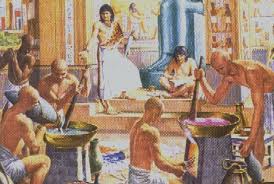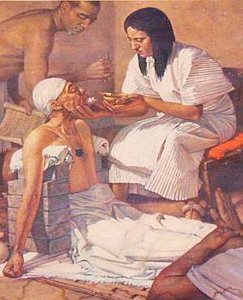Egypt Medicines is effective together with magic.
From the Ebers Papyrus
1/8th cup figs and grapes, bread dough, pit corn, fresh Earth, onion, and elderberry – was the cure for diarrhoea in ancient Egypt.
Ancient Egyptians were well equipped and well advanced in all areas and the field of medicine was no exception. Practices of healing were common in Egypt from 33 rd century BC until 525 BC.

The medicine was highly advanced for the time and included simple, non-invasive surgery, the setting of bones and an extensive set of pharmacopeia. The practices of Egyptian physicians ranged from embalming to faith healing to surgery, and autopsy.
A few papyri have been obtained from which we learn about Egyptian medicine. The Edwin Smith Papyrus and the Ebers Papyrus are the most important among them.
The former describes surgical diagnosis and treatment while the latter deals with ophthalmology and diseases of the digestive system. The Berlin, London, Hearst medical papyri are also helpful in knowing the medical advancement of the Egyptians.
Goddess of Healing
Sekhmet was the Egyptian goddess of healing, curses, and threats. Preventive measures included prayers and various kinds of magic, above all the wearing of amulets. Thus an ostrich egg is included in the treatment of a broken skull, and an amulet portraying a hedgehog might be used against baldness.

Health related amulets are classified as homeopathic, phyletic and theophoric. Homoeopathic amulets portray an animal or part of an animal, from which the wearer hopes to gain positive attributes like strength or speed. Phylactic amulets protected against harmful gods and demons. Theophoric amulets represented Egyptian gods.
Egyptians, especially those who were indulged in mummification process, had some knowledge of human anatomy. This is because the process involved removing most of the internal organs including the brain, lungs, pancreas, liver, spleen, heart and intestine.
Egyptian physicians were aware of the existence of the pulse and of a connection between pulse and heart. Though many medical practices were ineffective, the patients were asked to observe hygiene and maintain the diet.
‘Wabau’ was the term used for Egyptian doctors. There were many ranks and specializations in the field of medicine. Royalty employed their own specialists. There were inspectors of doctors, overseers and chief doctors. Known ancient Egyptian specialists are an ophthalmologist, gastroenterologist, proctologist, dentist etc.
The Tomb of the Physician at Saqqara shows pictures of treatment of men. The Egyptian treatments were based on examination, followed by diagnosis. The pots containing medicines were occasionally labeled, stating the Remedy’s composition and how to use it.
Egyptian healers engaged in surgery, prescriptive, and many other healing practices still found today. Among the creatives used by the Egyptians were all types of plant (herbs and other plants), animal (all parts nearly) and mineral compounds.
Importance of Herbs in Egypt Medicines
Herbs played a major part in Egyptian medicine. The plant medicines mentioned in the Ebers papyrus, for instance, include opium, cannabis, myrrh, frankincense, fennel, cassia, thyme, henna, juniper, aloe, linseed and castor oil.
Garlic was an important healing agent. Coriander and Cumin were also considered effective. Some Egypt Medicines were made of materials imported from abroad.